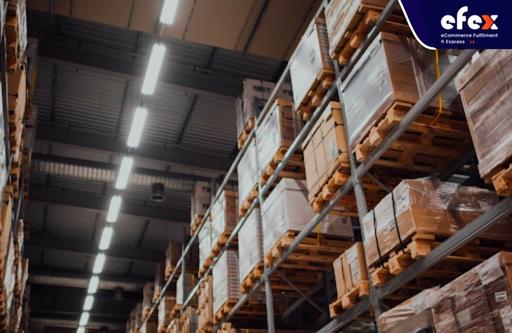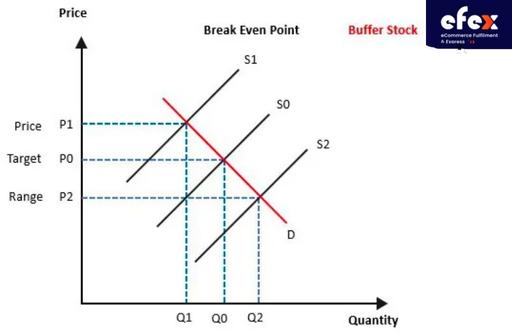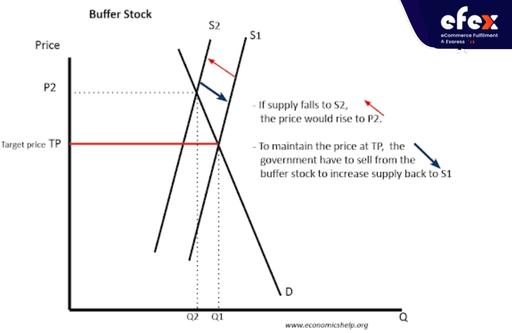
Food price volatility creates significant dangers, affecting everyone from producers to consumers, particularly in developing nations. It remains a critical policy priority since its destructive consequences on sustainable farming and food security, especially for the poor. That is the reason why governments have used various ways to keep domestic food prices stable, involving publicly maintained buffer stock, import and export levies, and production subsidies.

A buffer stock system or buffer stock scheme is a government scheme that is used to maintain price stability in a highly competitive market.
During excellent harvests, stocks are purchased and kept to avoid costs from dropping below-market prices or a goal range, and supplies are discharged during harvests to stop prices from increasing over price levels or a target range.
Agricultural commodity prices are frequently fluctuating for the following reasons: weather, inelastic demand, and fixed supply in the near future.
You can see the stock diagram below.

The graphic indicates that the stock price declines from P to P2, with P2 being known as times of good harvests. It is because the stocks will be purchased or held to avoid the prices of the items dropping below a target price range.
In other words, the price will adjust itself to the typical target price range with this buffer stock mechanism. However, if the price of the stocks rises from P to P1, due to poor harvests, the stocks will be removed to prevent the growing prices of the items from exceeding a target price range.
👉 Read More: What Is Cubic Capacity: Calculation, Benefit
👉 Read More: What Is Dynamic Slotting? Benefit And Feature
You can see that supply is decreasing in this instance. This price would grow to P2 in a free market just above the target price. To bring prices back to target, the government must sell items from buffer stock, bringing supply back up to S1.

Along with the biggest benefit of buffer stock which is to ensure the supply of foodstuffs and keep stable prices, buffer stocks also have some benefits that you can see below.

Besides its advantages, buffer stocks still have some disadvantages that you should know.


Here are a few examples that you can consider to understand more about buffer stocks.
Many goods have minimum pricing specified in the CAP. Therefore, it fueled oversupply. The EU was compelled to purchase the surplus. This overstock was kept in massive warehouses and barns, which are also referred to as buttery mountains, grain mountains, and wine lakes.

The initiative was mainly a failure since it became prohibitively expensive to continue purchasing overstock. There has never been a true scarcity. Finally, the EU was forced to establish quotas to manage surplus supplies. CAP was gradually changed to lower the targeted lowest prices.
In 2017, the Ivory Coast and Ghana intended to restart a cocoa buffer stock arrangement. The Ivory Coast and Ghana control more than 60% of the global supply. They faced a worldwide excess of 371,000 tonnes, which would result in lower pricing and fewer export earnings.
The Ivory Coast intends to construct warehouses capable of storing 250,000 tonnes of cocoa. According to one analysis, periods of buffer stock intervention were relatively successful in stabilizing agricultural earnings.

Keeping the wool price-stable was their goal. Wool has the advantage of being simple to store. During years of abundant production, the government may purchase and stockpile extra wool. During times of scarcity, the government will discharge wool from storage.
The project was abandoned because it became mostly about the government purchasing wool. During a period of diminishing demand, the system just incentivized farmers to continue producing wool instead of responding to shifting market signals.
China was founded in the first century BC. The goal was to stabilize supply by purchasing grain in strong years and transferring it to places experiencing shortages. Henry A. Wallace who was a future adviser to President Roosevelt renewed the concept. he borrowed the concept from Chinese history and gave it this name. The United States began using agricultural intervention in 1929. Government assistance for agriculture grew as a result of these 1930s policies and has been tough to remove.
In Genesis wheat storage, Joseph saved wheat stock for at least 7 years of feast, allowing him to distribute wheat from his stockpiles during the 7 years of famine.

The relevance of the buffer stock system is evident throughout the procurement target-setting process. Buffer stocks are extra food stocks held in godowns. This strategy aids in the equitable distribution of food across a country. These food reserves can be utilized to meet food requirements when agricultural production rates decline due to illnesses or harsh weather events like droughts and floods.
Furthermore, it aids in the ongoing regulation and management of prices. Sending food supplies to communities in need becomes more convenient using this technique.

👉 Read More: 3PL Warehouse Services: Benefits And Offers
👉 Read More: All Cost To Rent A Warehouse
A buffer stock scheme is a government plan designed to stabilize prices in a competitive market. Its goal is to maintain price stability, provide an ongoing supply of commodities, and save farmers and manufacturers from closing down their businesses as a result of an expected price drop. A buffer stock program includes the EU cap, the International Cocoa Organization, the 1960 wool floor pricing scheme in Australia, the ever-normal granary, and the Genesis wheat storage. Hope you have a good time with Efex.
